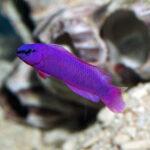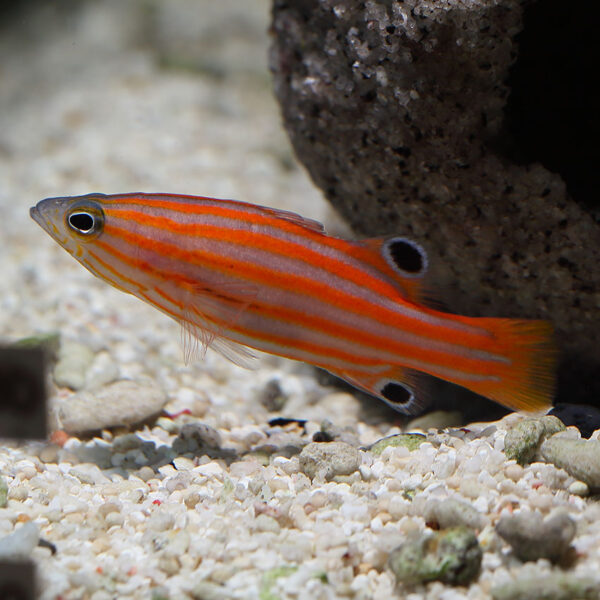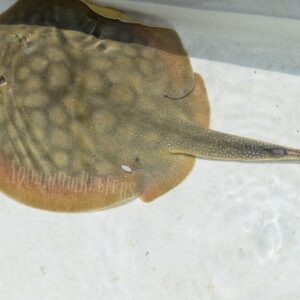Description
The Tangerine Swiss Guard, Liopropoma swalesi, is a visually striking fish with a maximum size reaching around 3 inches (7.6 cm) in length. It features a vibrant tangerine-orange body colouration that extends from the head to the tail. The dorsal fin is elongated and flows gracefully, adding to its overall elegance. Its slender body shape and prominent eyes contribute to its captivating appearance.
Natural Habitat:
In its natural habitat, the Tangerine Swiss Guard can be found in the Caribbean Sea. It inhabits coral reefs and rocky areas, typically in depths ranging from 30 to 100 feet (9 to 30 meters). These reefs are rich in diverse coral formations and provide a variety of hiding spots, crevices, and caves for the fish to seek shelter and protection.
Keeping the Tangerine Swiss Guard:
The Tangerine Swiss Guard requires attentive care to ensure its health and well-being. It is considered moderately difficult to keep, requiring an experienced aquarist. Water parameters should be closely monitored, with a temperature range of 75-80°F (24-27°C), a pH level of 8.1-8.4, and a KH range of 8-12 dKH. Stable and high-quality water conditions are crucial for the Tangerine Swiss Guard’s overall health.
Special Requirements and Feeding:
The Tangerine Swiss Guard is carnivorous and should be fed a varied diet consisting of small meaty foods such as mysis shrimp, brine shrimp, and high-quality frozen preparations. Providing a diverse diet helps ensure it receives the necessary nutrients for optimal health. It is important to feed this species small frequent meals throughout the day rather than a single large meal.
How Many Should I Keep?
The Tangerine Swiss Guard is typically kept individually or in pairs. Keeping more than one male in the same tank may result in territorial aggression. It is advisable to provide each fish with ample space and hiding spots to establish their territories and reduce potential conflicts.
Lighting Preference:
The Tangerine Swiss Guard benefits from a well-lit aquarium that mimics natural lighting conditions found in its native habitat. It thrives under moderate to high lighting levels, which enhances the visibility of its vibrant orange coloration and promotes the growth of beneficial microalgae.
Suitable Tank Mates:
When considering tank mates for the Tangerine Swiss Guard, it is important to select species that are compatible in terms of size, temperament, and water requirements. Avoid housing it with aggressive or territorial fish that may pose a threat. Suitable tank mates include peaceful reef fish, small to medium-sized non-aggressive species, and other compatible basslets or dottybacks.
Breeding Liopropoma swalesi:
Breeding the Tangerine Swiss Guard, Liopropoma swalesi, in captivity can be challenging, and successful breeding attempts are relatively rare. These fish are not commonly bred in home aquariums, and most specimens available in the trade are wild-caught.
To increase the chances of breeding success, it is important to provide the fish with optimal conditions and a suitable environment. Here are some factors to consider:
- Water Parameters:
Maintaining stable and pristine water conditions is crucial. The temperature should be maintained within the range of 75-80°F (24-27°C), with a pH level of 8.1-8.4. Ammonia, nitrite, and nitrate levels should be kept at undetectable levels, and regular water changes are essential.
- Tank Setup:
Provide the Tangerine Swiss Guard with a well-established aquarium that mimics its natural habitat. The tank should have plenty of hiding spots such as caves, crevices, and rock formations where the fish can seek refuge.
- Pairing:
Breeding is most successful when a compatible male and female are paired together. However, determining the sex of Tangerine Swiss Guard can be challenging, as they do not exhibit significant sexual dimorphism. It is often recommended to acquire a group of young specimens and allow a pair to form naturally over time.
- Courtship Behaviour:
The breeding process typically involves courtship displays and rituals by the male to attract the female. These displays may include fin flaring, circling, and colour intensification. The male may also create a nest or clean a specific spawning site in preparation for spawning.
- Spawning:
Once the pair has formed, the male will lead the female to the chosen spawning site. Spawning usually occurs during the evening or early morning hours. The female releases eggs, and the male fertilizes them externally. After spawning, the male will guard and fan the eggs to ensure proper oxygenation.
- Egg and Larval Care:
The eggs are adhesive and will attach to the chosen substrate. The male continues to guard the eggs, removing any unfertilized or damaged ones. The eggs hatch within a few days, and the larvae enter a pelagic stage, drifting in the water column. Providing appropriate food for the newly hatched larvae is challenging, as they require tiny, live food such as rotifers and copepods.
- Specialized Breeding Facilities:
Due to the complexities involved in breeding the Tangerine Swiss Guard, successful breeding attempts are more commonly achieved in specialized facilities with dedicated systems and experienced breeders.
It is important to note that breeding marine fish in captivity can be a complex and demanding process. It requires a deep understanding of the species’ behaviour, specific environmental conditions, and specialized equipment. Therefore, breeding the Tangerine Swiss Guard may not be feasible for most hobbyists and is usually undertaken by experienced aquarists and commercial breeding facilities.
Sexual Dimorphism:
Sexual dimorphism in the Tangerine Swiss Guard is not well-documented. Distinguishing between males and females based on physical characteristics can be challenging, as both sexes exhibit similar colouration and body shape.
Distribution:
The Tangerine Swiss Guard, Liopropoma swalesi, is naturally distributed in the Caribbean Sea, specifically in regions such as the Bahamas, Florida, and the Caribbean islands. It is primarily collected from the wild, and captive-bred specimens of this species are rare.
Summary:
The Tangerine Swiss Guard, Liopropoma swalesi, is a visually striking fish with a vibrant tangerine-orange colouration. With a maximum size of around 3 inches (7.6 cm), it adds a pop of colour to any aquarium. Found in the Caribbean Sea, it thrives in coral reefs and rocky areas. While its care level is moderately difficult, providing stable water parameters within the temperature range of 75-80°F (24-27°C) and pH range of 8.1-8.4 is essential. Feeding the Tangerine Swiss Guard a varied diet of small meaty foods ensures its nutritional needs are met. It is best kept individually or in pairs, and suitable tank mates include peaceful reef fish. Breeding this species in captivity is challenging, and most specimens available in the trade are wild-caught. Overall, the Tangerine Swiss Guard is a captivating addition to a marine aquarium, but it requires experienced care due to its delicate nature.
The Fish pictured here are representative only and the livestock you receive may vary in pattern, coloration, and shape.









Reviews
There are no reviews yet.